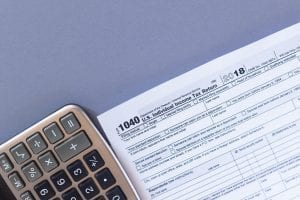It’s the start of a new year, and with that, the start of the 2020 tax filing season. These next few months can be complicated for taxpayers. On the one hand, we’re looking back at 2020 to prepare our returns and file by the April 15 deadline. But at the same time, we’re already looking ahead to the 2021 tax year, and planning our finances accordingly.
Since tax brackets get adjusted every year for inflation, you could still wind up paying a different rate from year to year even if your income doesn’t change. So, let’s take a look at both the 2020 and 2021 Federal Income Tax Brackets.
How Do Tax Brackets Work?
Tax brackets are used to determine your marginal income tax rate. We use the word marginal because your tax bracket does not describe an absolute tax rate.

For example, say you’re a single filer and made $65,000 in 2020 – you’d fall into the bracket for a 22% marginal rate. This does not mean your whole income is taxed at 22%. Instead, it means that the first $9,875 of your income is taxed at 10%. Your next $30,250 of income (the amount from $9,875 to $40,125) is taxed at 12%, and the rest is taxed at 22%.
If you were taxed at a flat rate of 22%, your income tax would amount to $14,300. Instead, your bill comes out to $12,262.50.
This marginal tax system results in lower taxes and eliminates unfair penalties for entering higher tax brackets.
How Do I Know Which Tax Bracket I’m in?
All you need to know to determine your tax bracket is your income and your filing status.
If you’re a single individual or a married individual filing separately, use the column on the left side of the chart below to find the marginal tax rate corresponding with your annual income.
Married couples filing jointly will use the middle column. Each tax bracket for couples is twice as large as those for individuals.
And finally, heads of households will use the column on the right. To qualify as a head of household, you must:
- you must be unmarried,
- you must pay for at least half the cost of keeping up a home,
- and a qualifying person must live in that home with you for more than half a year.
Once you’ve determined your filing status, reference the charts below to calculate a marginal tax rate based on your annual income.
2020 Income Tax Brackets
These are the tax brackets you’ll use to prepare your 2020 returns.
| Rate | For Single Individuals, or Married Individuals Filing Separately | For Married Couples Filing Joint Returns | For Heads of Households |
| 10% | Up to $9,875 | Up to $19,750 | Up to $14,100 |
| 12% | $9,876 to $40,125 | $19,751 to $80,250 | $14,101 to $53,700 |
| 22% | $40,126 to $85,525 | $80,251 to $171,050 | $53,701 to $85,500 |
| 24% | $85,526 to $163,300 | $171,051 to $326,600 | $85,501 to $163,300 |
| 32% | $163,301 to $207,350 | $326,601 to $414,700 | $163,301 to $207,350 |
| 35% | $207,351 to $518,400 | $414,701 to $622,050 | $207,351 to $518,400 |
| 37% | $518,401 or more | $622,051 or more | $518,401 or more |
2021 Income Tax Brackets
These are the tax brackets for the tax year 2021, which you’ll file next year. Though the same rates (10%, 12%, 22%, 24%, 32%, 35%, 37%) are used, the dollar cutoffs for each bracket are a bit higher to account for inflation.
| Rate | For Single Individuals, or Married Individuals Filing Separately | For Married Couples Filing Joint Returns | For Heads of Households |
| 10% | Up to $9,950 | Up to $19,900
|
Up to $14,200
|
| 12% | $9,951 to $40,525 | $19,901 to $81,050
|
$14,201 to $54,200
|
| 22% | $40,526 to $86,375 | $81,051 to $172,750
|
$54,201 to $86,350
|
| 24% | $86,376 to $164,925
|
$172,751 to $329,850
|
$86,351 to $164,900
|
| 32% | $164,926 to $209,425
|
$329,851 to $418,850
|
$164,901 to $209,400
|
| 35% | $209,426 to $523,600
|
$418,851 to $628,300
|
$209,401 to $523,600
|
| 37% | Over $523,600 | Over $628,300
|
Over $523,600
|
Contact Boxelder Consulting
If you need help determining your filing status, taxable income, or marginal tax rate, give us a call at 303-317-6111 for a free consultation. This process can be confusing and stressful if handled alone. Our team of licensed tax attorneys and accountants can help you file your returns accurately and maximize your deductions.
And if you’re behind on your taxes, don’t hesitate to reach out. Take the first step towards resolution and give us a call. We believe in second chances.
